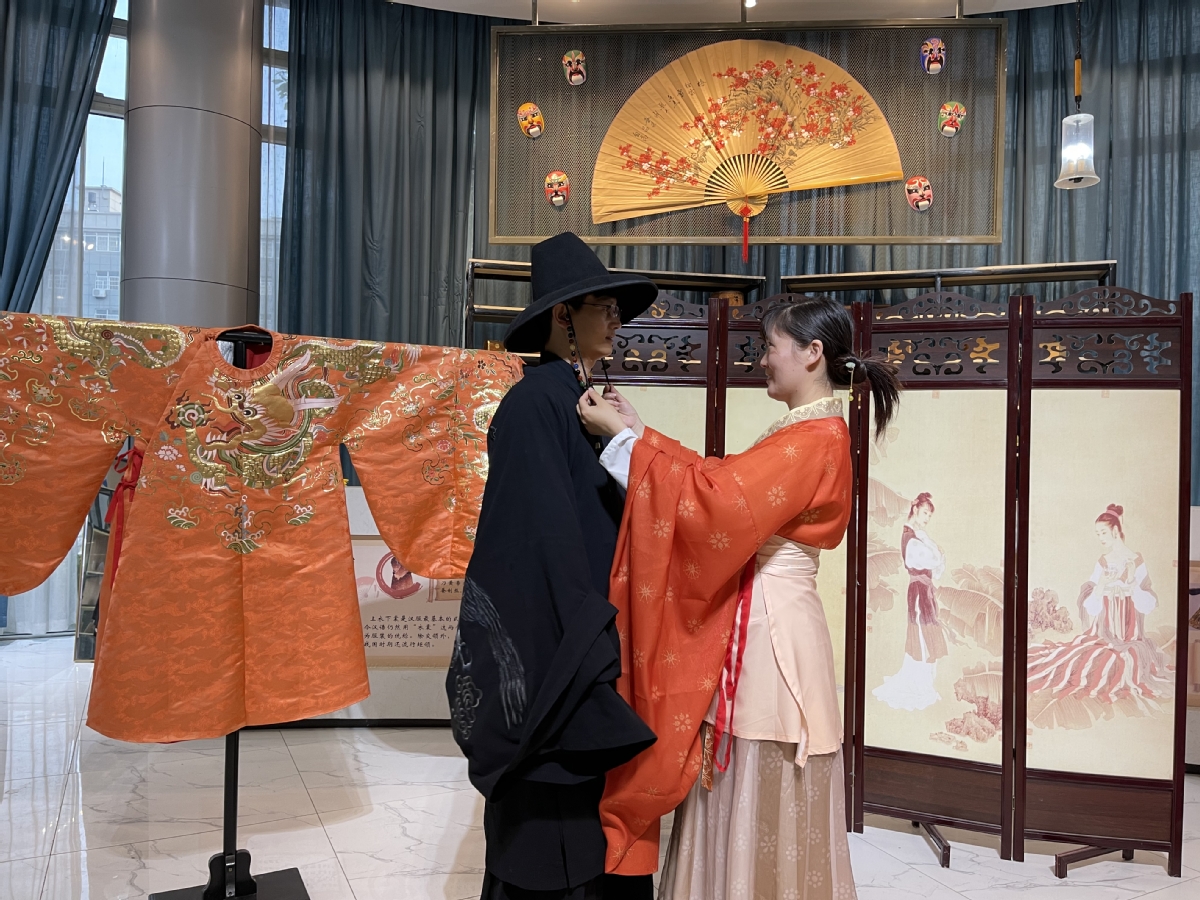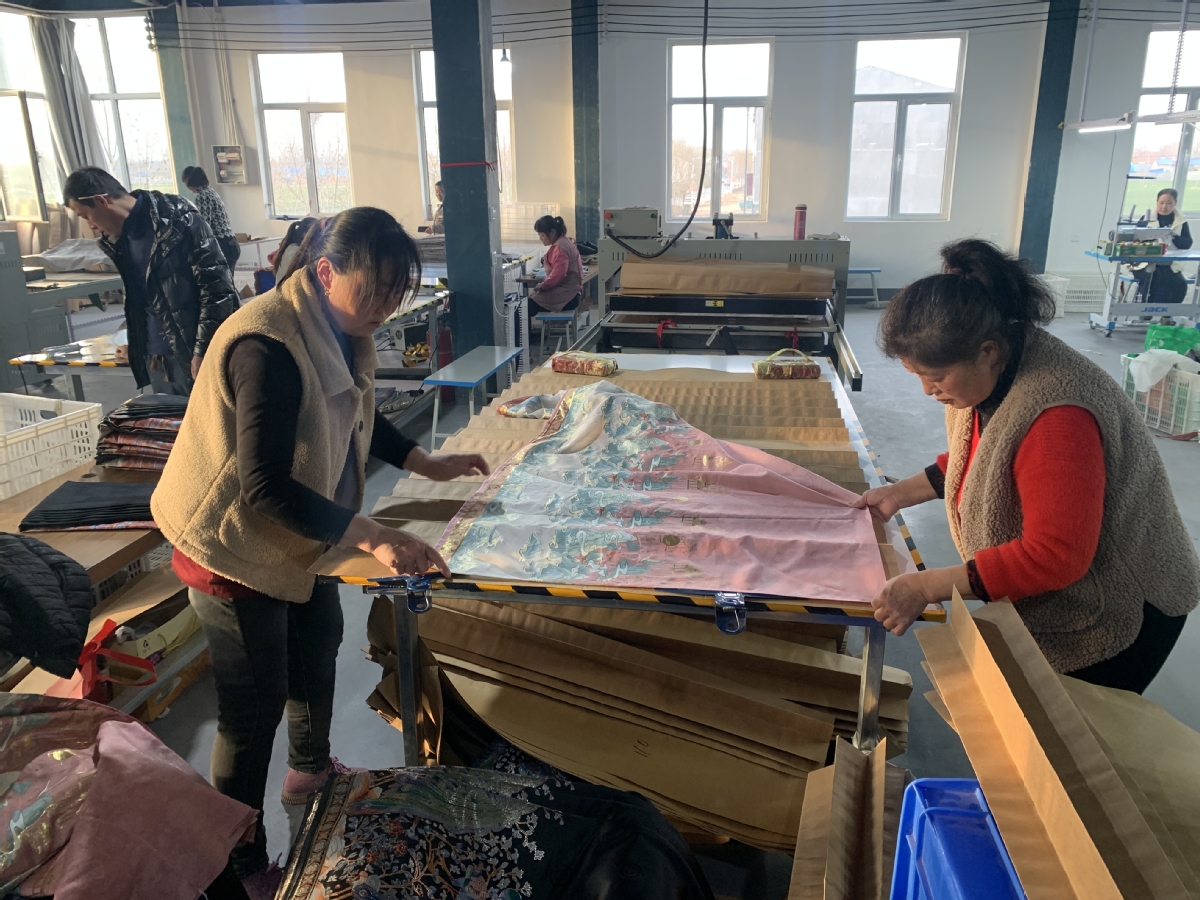Young buyers snap up snazzy traditional outfits

A staff member (right) of a hanfu company arranges attire for a model in Caoxian county, Shandong province, in 2021. CHINA DAILY
Traditional Chinese attire that incorporates stylish modern designs is becoming popular among consumers this year, driven by the younger generation's fondness for the country's cultural heritage, and thereby fueling more business opportunities for retailers.
During the Spring Festival holiday in February, various traditional Chinese-style outfits containing dragon and phoenix elements became quite the rage among young consumers, as such clothing integrates Chinese design elements into various kinds of daily wear.
In Chinese traditional astrology, which outlines the qualities of 12 zodiac signs, the Year of the Dragon is usually of great significance, as the dragon symbolizes strength, wisdom and good fortune for Chinese people. This has spurred the popularity of traditional Chinese elements.
In addition, an increasing number of Chinese celebrities have frequently chosen locally designed traditional Chinese outfits, encouraging young consumers to wear such garments.
Since the beginning of this year, online search volumes for Tang suits and hanfu, two kinds of traditional Chinese-style attire, have skyrocketed.
Horse-faced skirts, or mid-length skirts with a distinguishing pleated design, have become the most popular item in the hanfu category, according to Alibaba's e-commerce platform Taobao.
This type of skirt is a key component of hanfu, the traditional dress worn by Han Chinese women.
During the Nov 11 online shopping extravaganza last year, more than 730,000 pieces of horse-faced skirts were sold on Taobao.
Meanwhile, more young parents have bought traditional-style Chinese clothing for their children, especially girls. In January, the turnover of children's clothing in the Tang suit style surged more than 330 percent year-on-year, according to Taobao.
"The booming sales growth of traditional Chinese-style clothing comes from young consumers' sense of identification with traditional Chinese culture, which also indicates a rise in national confidence," said Li Lina, director of women's clothing at Taobao.
"Such cultural confidence has fueled more business opportunities for retailers, and the main challenge for designers and retailers lies in how to integrate traditional costumes with different modern scenes," Li added.

Workers stitch pleats on a horse-faced skirt at an e-commerce industrial park in Caoxian on March 7. CHINA DAILY
Production base
Caoxian, a small county in Heze in East China's Shandong province, is a popular production base for traditional Chinese-style clothing.
The county boasts the highest degree of industrialization in producing cost-effective hanfu.
In terms of the design and quality of outfits, Jiangsu, Zhejiang, Sichuan and Guangdong provinces have more advantages, according to a report by iResearch Consulting Group, a domestic market research firm.
Han Meng, head of Daji township government in Caoxian, said some 400 college graduates have returned to their hometowns for entrepreneurship. He said the town is known for its e-commerce business, and the first thing that many young people do when they return home is to open an online store on Taobao.
"The town of Daji is a vibrant place. Market demand is reflected online rapidly, and the development of e-commerce businesses has created flexible entrepreneurial ideas for people living in the town," Han said.
Daji has more than 30 villages involved in online businesses. Earlier, the villages were filled with the elderly and children, as young adults went to other places for work. Now, supported by the booming cloth production business, the villages are prosperous, with numerous cars, restaurants and diversified entertainment options.
Liu Shenfeng, who previously worked as a teacher at a fashion design college in Heze, returned to Daji in 2010 and was among the first group of entrepreneurs to start their own business in the town.
Liu now owns three online stores on Tmall, an e-commerce platform of Alibaba Group, and also operates brick-and-mortar stores.
Sales revenue for a variety of horse-faced skirts at Liu's store exceeded 10 million yuan ($1.39 million) in the month preceding Spring Festival this year, and employees at his store were extremely busy, packing and sending express deliveries.
"During the Spring Festival break, we took a few days off, and about 1,000 to 2,000 customers inquired online daily if products were still available," Liu said.
After the Lantern Festival, or the 15th day of the Lunar New Year, Liu's store was up again. He plans to raise the production volume by three to five fold this year to meet the growing demand.
Mona Hao, a 29-year-old who works at an internet tech firm in Hangzhou, Zhejiang province, owns more than 100 sets of hanfu, mainly bought online. The price of a single piece ranges between 300 yuan and 500 yuan, or higher.
Since her childhood, Hao has worn Tang suits during Spring Festival. Wearing traditional Chinese attire has increasingly become a daily habit and she wears it to work, too, sometimes.
For this year's Spring Festival holiday, she chose a red winter-style hanfu, with fur jackets and fluffy scarves to match.
Besides hanfu, Tang suits have incorporated various stylish elements in addition to retaining the look of a traditional jacket and using woven brocade.
For instance, some use silk and genuine leather as fabric, and integrate new elements such as standing collars made of wool, improved style of buckles and other modern patterns.
Designers have been taking elements from traditional culture and the latest trends, such as seasonal trendy colors, betting on some potentially popular styles, industry players have said.
In addition, costumes of ethnic minorities, such as robes of the Xizang and Inner Mongolia autonomous regions, have become more popular among young Chinese.
Such outfits appear frequently during Chinese New Year and are sold throughout the country.
"Apparel, as an indispensable part of people's daily life, has exceeded its basic wearing function for a long time and become an important way for consumers to showcase their personalities and preferences," said Lou Lei, executive director of consultancy Frost &Sullivan China.
From 2017 to 2023, sales of footwear and clothing of domestic brands that integrated Chinese cultural elements grew from 407.1 billion yuan to 992.8 billion yuan, with a compound annual growth rate of nearly 16 percent. It is significantly higher than the overall compound annual growth rate of footwear and clothing during the same period, according to Frost & Sullivan.
"Such fast growth is mainly due to the strong rise of local brands, the continuous growth of China-chic brand competitiveness, and a significant increase in consumers' recognition of domestic products," Lou said.
Related articles
-
 Huafu: Wearable History
Huafu: Wearable HistoryMore
-
 Tibetans wear traditional costumes for Losar
Tibetans wear traditional costumes for LosarMore
-
 People in traditional costumes celebrate traditional Flower Festival in Fujian
People in traditional costumes celebrate traditional Flower Festival in FujianMore
-
 Embroidery evolves into thriving business in SW China's Guizhou
Embroidery evolves into thriving business in SW China's GuizhouMore
-
 Miao people participate in traditional dancing activity in SW China's Guizhou
Miao people participate in traditional dancing activity in SW China's GuizhouMore
-
 Rediscovering Chinese aesthetics
Rediscovering Chinese aestheticsMore
